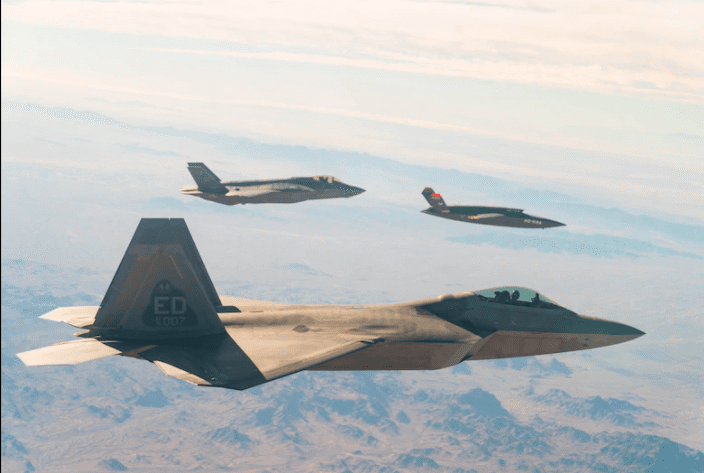
The Air Force completed a successful test flight that demonstrated the ability of two fifth-generation aircraft and an unmanned combat aerial vehicle (UCAV) to communicate in their secure native languages without the need for legacy tactical data connections. (Air Force)
The Air Force completed a flight test that demonstrated the ability of two fifth-generation aircraft and an unmanned combat aerial vehicle (UCAV) to communicate in their secure native languages without the need for legacy tactical data connections, according to a Dec. 9 U.S. Air Force press release. The test flight also marked the first time the XQ-58A Valkyrie, an unmanned combat aerial vehicle (UCAV), conducted a semi-autonomous flight with the F-35 and F-22.
The success of the test flight is the next step toward an Air Force element of the military Internet of Things (IoT). The test flight occurred at Yuma Proving Ground in Arizona and involved an F-22 Raptor, F-35A Lightning II, and an attritableONE XQ-58A Valkyrie. The F-22 and F-35A communicated through gatewayONE, according to the release.
“The gatewayONE payload really showed what’s possible and helped us take a big step towards achieving (Joint All-Domain Command and Control),” Lt. Col. Eric Wright, a 59th Test and Evaluation Squadron F-35 pilot, said in a press statement. “This critical capability provides additional connections between our advanced fighters and other forces and battle managers across all domains. The future is promising, and gatewayONE will allow the F-22 and F-35 to connect to and feed data sources they’ve never before accessed. Those future connections will bring additional battlefield awareness into the cockpit and enable integrated fires across U.S. forces.”
GatewayONE allows battle managers on the ground and air to manage operations. Using this platform, the position data of each platform was pushed outside of the aircraft’s close proximity formation, according to the release. The communication occurred not only between the ground and air but also between the aircraft.

The success of the test flight is the next step toward a military Internet of Things (IoT). The test flight occurred at Yuma Proving Ground in Arizona and involved an F-22 Raptor, F-35A Lightning II, and an attritableONE XQ-58A Valkyrie. (Air Force)
“If fifth-generation platforms are going to be quarterbacks of a joint-penetrating team, we have to be able to communicate with those quarterbacks in an operationally relevant manner and enable data sharing between them, to them, and from them. For years people said it couldn’t be done. Today the team turned another page toward making the impossible possible,” Preston Dunlap, Air and Space Force’s chief architect, said in a press statement. “In just 12 months, the team has opened the door to a world where we can put the power of an operations center into the cockpit at the tactical edge.”
The XQ-58 Valkyrie completed the test flight alongside the F-22 and F-35, which was also the first semi-autonomous flight for the UCAV. However, while the gatewayONE payload was integrated on to the UCAV, the communications were lost shortly after takeoff.
“Testing is all about pushing the limits of what’s possible, finding out where the toughest challenges are, and adapting creative solutions to overcoming difficult problem sets,” Lt. Col. Kate Stowe, gatewayONE program manager at the Air Force Lifecycle Management Center, said in a press statement. “The real win of the day was seeing the gatewayONE establish a secure two-way translational data path across multiple platforms and multiple domains. That’s the stuff ABMS is all about.”